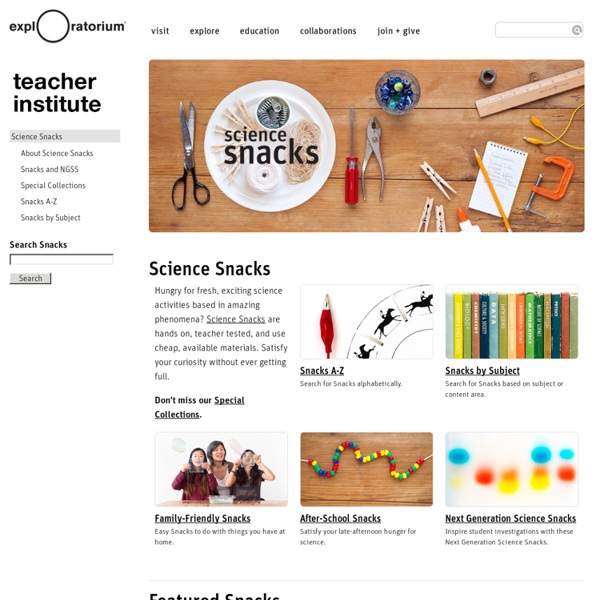



http://www.exploratorium.edu/snacks
Related: EXPERIMENTSArvind Gupta Our core belief is that children learn by doing - by touching, feeling, cutting, sticking -- pulling things apart, putting things together. We believe that this hands-on science helps them relate to curriculum and get conceptual understanding. We believe this will revolutionize the way children learn. A child lighting up a LED with a Syringe Generator is more likely to light up his village tomorrow. Our approach is inclusive.
A Better Way to Teach? Any physics professor who thinks that lecturing to first-year students is the best way to teach them about electromagnetic waves can stop reading this item. For everybody else, however, listen up: A new study shows that students learn much better through an active, iterative process that involves working through their misconceptions with fellow students and getting immediate feedback from the instructor. The research, appearing online today in Science, was conducted by a team at the University of British Columbia (UBC), Vancouver, in Canada, led by physics Nobelist Carl Wieman. First at the University of Colorado, Boulder, and now at an eponymous science education initiative at UBC, Wieman has devoted the past decade to improving undergraduate science instruction, using methods that draw upon the latest research in cognitive science, neuroscience, and learning theory. “It’s almost certainly the case that lectures have been ineffective for centuries.
Edible/Inedible Experiments Archive Science should be fun.. science should be edible.. Try your hand at experimental science! Some experiments may be eaten before, during or after the experiment, and some should not be eaten at all! Each file lists an expected age-level to carry out the experiment, as well as safety precautions. 6 Virtual Tours Of The Human Body For Free Interactive Anatomy Lessons When it comes to interactive virtual views, we have gone to space and around the globe. So, it’s not surprising that we are also going within ourselves on a virtual journey of the human body. One of the finest tools available online is Visible Body. Christmas star › Tricks (ABC Science) The Surfing Scientist › Tricks Celebrate the Yuletide with this classic trick. Five wooden toothpicks, a straw and some water are all you need to be the Christmas dinner science star. By Ruben Meerman Can't see the video?
Healthy Kids : Healthy Kids Activities Think a vegetable can’t teach you anything? Well think again! Try these cool experiments and activities and see what you learn! Colourful celery experiment Place a celery stalk in a clear container. Fill it up three-quarters full with brightly coloured water (just add some food colouring). Science Fair Ideas Video for Kids - Be captivated watching the excellent selected and really easy to understand Science Fair Ideas facts for kids video: This is a great video that shows fun experiments you can do that is about exothermic reactions. With this video, you will be able to see the “hot ice” experiment, which turns water into ice with just a touch of a finger. You will find a list of the materials needed for this project in the video. The video will show the step by step tutorial on how to make this project and demonstrates different kinds of experiments that show the same principle. Watch this beneficial Science Fair Ideas facts for kids video and considerably boost your young kid’s interest in Science Fair Ideas.
Make a Liquid Layers Density Column When you see liquids stack on top of each other in layers, it's because they have different densities from each other and don't mix well together. You can make a density column—also known as a density tower—with many liquid layers using common household liquids. This is an easy, fun and colorful science project that illustrates the concept of density. Density Column Materials You can use some or all of these liquids, depending on how many layers you want and which materials you have handy. These liquids are listed from most-dense to least-dense, so this is the order you pour them into the column:
How to Make a Cloud in a Bottle - Science Demonstration Here's a quick and easy science project you can do: make a cloud inside a bottle. Clouds form when water vapor forms tiny visible droplets. This results from cooling the vapor. It helps to provide particles around which the water can liquefy. In this project, we'll use smoke to help form a cloud. Cloud in a Bottle Materials
How Do You Prove Air Has Volume (Takes Up Space)? Air, and how it behaves and moves, is important to understanding the basic processes that lead to weather. But because air (and the atmosphere) is invisible, it can be hard to think of it as having properties like mass, volume, and pressure -- or even being there at all! These simple activities and demos will help you prove that air indeed has volume (takes up space). Difficulty: Easy